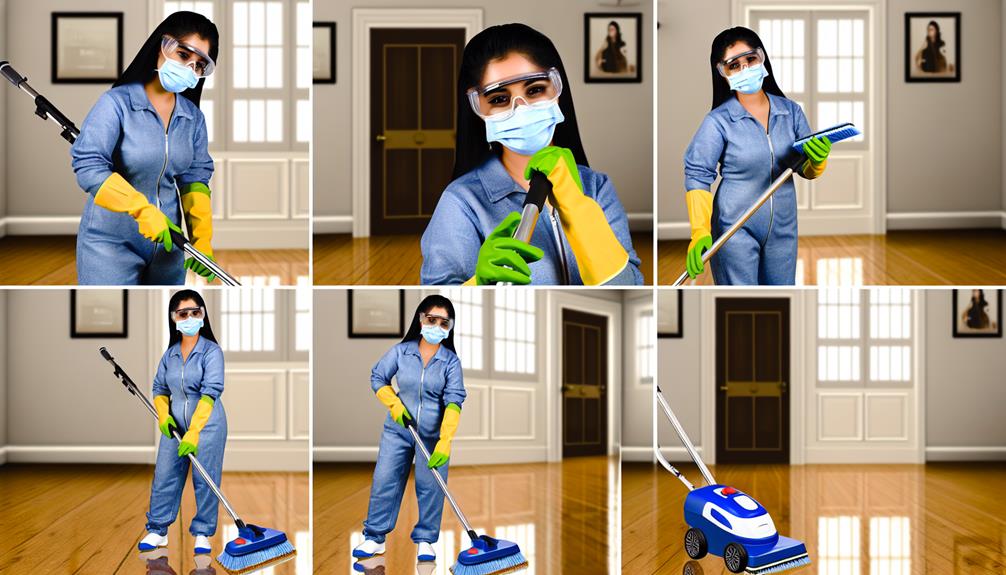You walk into a room, and your eyes are drawn to the gleaming, perfectly polished floor beneath your feet. How can you achieve that level of perfection yourself? By following these 7 straightforward steps, you'll be on your way to mastering the art of floor polishing. From the initial preparation to the final maintenance tips, each step plays a crucial role in ensuring your floors shine with impeccable brilliance. So, are you ready to transform your floors into a flawless reflection of your dedication to detail?
Key Takeaways
Contents
- 1 Key Takeaways
- 2 Floor Preparation
- 3 Clearing the Surface
- 4 Choosing the Right Polish
- 5 Applying the Polish
- 6 Buffing and Polishing
- 7 Final Touches
- 8 Maintenance Tips
- 9 Frequently Asked Questions
- 9.1 Can I Use Floor Polish on All Types of Flooring?
- 9.2 How Long Should I Wait Before Walking on the Polished Floor?
- 9.3 Will Floor Polish Protect Against Scratches and Stains?
- 9.4 Can I Apply Multiple Coats of Floor Polish for Extra Shine?
- 9.5 What Should I Do if the Floor Polish Leaves Streaks or Residue?
- Clean and prepare the floor surface thoroughly before polishing.
- Choose the right polish suitable for the floor material and desired gloss level.
- Apply the polish evenly in thin layers using a clean cloth.
- Use high-quality buffing machines and work methodically for even polishing.
- Inspect the surface for missed spots, wipe away residue, and consider applying a floor sealant for protection.
Floor Preparation
Before beginning the floor polishing process, proper floor preparation is essential to ensuring a successful outcome.
The first step is to thoroughly clean the floor surface. Remove any debris, dust, or dirt using a broom, vacuum, or mop. It's crucial to eliminate all particles that could interfere with the polishing process.
Next, inspect the floor for any cracks, holes, or imperfections. Fill these areas with a suitable filler to ensure a smooth and even surface for polishing.
Pay attention to detail, as any remaining blemishes could impact the final result.
After filling in any imperfections, ensure the floor is completely dry before proceeding. Moisture on the surface can affect the polish application and result in an uneven finish.
Use a moisture meter to confirm that the floor is dry enough for polishing.
Lastly, if necessary, apply a primer or sealer to the floor surface before polishing. This extra step can enhance the adhesion of the polish and improve the overall durability of the finish.
Proper floor preparation sets the foundation for a flawless polishing process.
Clearing the Surface
To effectively clear the surface before proceeding with the floor polishing process, start by meticulously removing any remaining dust, dirt, or debris that could impede the polishing results.
Begin by sweeping the entire area with a broom to collect larger particles. Follow this by using a vacuum cleaner to capture finer dust and debris in corners and along edges.
For hard-to-reach spots, use a microfiber cloth or brush to ensure thorough cleaning. Pay special attention to baseboards, as they tend to accumulate dust and grime.
Once the surface is free of visible dirt, consider using a mild detergent solution to wipe down the floor, especially in areas with stubborn stains. Rinse the surface with clean water and allow it to dry completely before proceeding with the polishing process.
Choosing the Right Polish
Having prepared the surface meticulously for the floor polishing process, the next crucial step is selecting the right polish to achieve the desired results.
When choosing a polish, consider the type of flooring you have. For hardwood floors, opt for a polish specifically designed for wood to enhance its natural beauty and protect it from wear and tear. For stone or tile floors, choose a polish that's suitable for those specific materials to ensure a lasting shine without causing damage.
Additionally, take into account the level of gloss you desire. Polishes come in various finishes ranging from matte to high-gloss, so select one that aligns with your aesthetic preferences.
If you're aiming for a subtle sheen, a satin finish might be ideal, while a high-gloss polish will deliver a more reflective surface.
Moreover, consider the durability of the polish. Some polishes offer extra protection against scratches and scuffs, which is beneficial for high-traffic areas.
Applying the Polish
When applying the polish to your floor, remember to start by ensuring that the surface is clean and dry. Any dirt or debris left on the floor can affect the polish's adhesion and overall finish.
Begin by thoroughly sweeping or vacuuming the floor to remove any dust or particles. Next, clean the floor with a mild detergent and water solution to eliminate any stubborn stains or grime. Allow the floor to dry completely before proceeding with the polish application.
Once the floor is clean and dry, pour a small amount of polish onto the floor in a manageable section. Use a clean microfiber cloth or applicator pad to spread the polish evenly in a thin layer.
Work in small, overlapping circular motions to ensure thorough coverage. Avoid applying too much polish at once, as this can lead to uneven drying and streaks on the floor. Repeat this process until the entire floor is polished, allowing each section to dry before walking on it.
Buffing and Polishing
As you move on to the essential step of buffing and polishing your floor, it's crucial to understand the significance of this process in enhancing the overall appearance and durability of the surface.
This process is vital to master, as it can make a huge difference in the final result.
- Choose the Right Equipment: Select high-quality buffing and polishing machines to achieve professional results.
- Use the Correct Products: Utilize the appropriate polishing compounds and pads for your specific type of flooring.
- Follow a Systematic Approach: Divide the floor into sections and work methodically to ensure even polishing.
- Control Pressure and Speed: Maintain consistent pressure and adjust the speed of the machine to achieve the desired level of shine.
Final Touches
To perfect the final touches of your floor polishing process, attention to detail is key.
After buffing and polishing your floor to a pristine shine, it's crucial to ensure that every aspect of the job is flawless. Begin by thoroughly inspecting the entire surface for any missed spots or imperfections.
Use a clean, dry cloth to gently wipe away any remaining residue or streaks. Pay special attention to corners and edges, as these areas can often be overlooked during the initial polishing process.
Next, take a step back and view the entire floor from different angles to catch any reflections that may indicate uneven polishing.
If you notice any dull patches or inconsistencies, go over them again with a polishing pad until the surface is cohesive and gleaming.
Finally, consider applying a thin layer of floor sealant to protect your hard work and maintain the shine for longer.
Maintenance Tips
For maintaining the pristine shine and durability of your polished floor, consistent and proper care is essential.
To ensure your floor stays in top condition, follow these maintenance tips:
- Regular Cleaning: Dust and dirt can scratch the surface of your polished floor, so sweep or vacuum frequently.
- Avoid Harsh Chemicals: Stick to pH-neutral cleaners to prevent damage to the polish and finish of your floor.
- Immediate Spill Cleanup: Accidents happen, but it's crucial to clean up spills promptly to prevent stains or damage.
- Protective Measures: Consider using furniture pads or rugs in high-traffic areas to prevent scratches and wear.
Frequently Asked Questions
Can I Use Floor Polish on All Types of Flooring?
You can use floor polish on various flooring types, but be cautious. It's like a painter choosing the right brush for different canvases. Check product labels for compatibility with your flooring to ensure a successful polish.
How Long Should I Wait Before Walking on the Polished Floor?
After polishing the floor, wait at least 24 hours before walking on it. This allows the polish to fully dry and set, ensuring a smooth and durable finish. Patience in this step will result in a beautifully polished floor.
Will Floor Polish Protect Against Scratches and Stains?
When you polish your floor, the polish acts as a shield against scratches and stains, preserving its beauty and longevity. Proper application and maintenance are key to ensuring your floor stays protected and looking flawless.
Can I Apply Multiple Coats of Floor Polish for Extra Shine?
Yes, you can apply multiple coats of floor polish for extra shine. Each layer adds depth and durability to the finish. Remember to allow proper drying time between coats to ensure a flawless and long-lasting glossy appearance.
What Should I Do if the Floor Polish Leaves Streaks or Residue?
If the floor polish leaves streaks or residue, try buffing the surface with a clean, dry microfiber cloth. If that doesn't work, lightly dampen the cloth with water and gently rub the affected areas. Avoid adding more polish until the issue is resolved.

